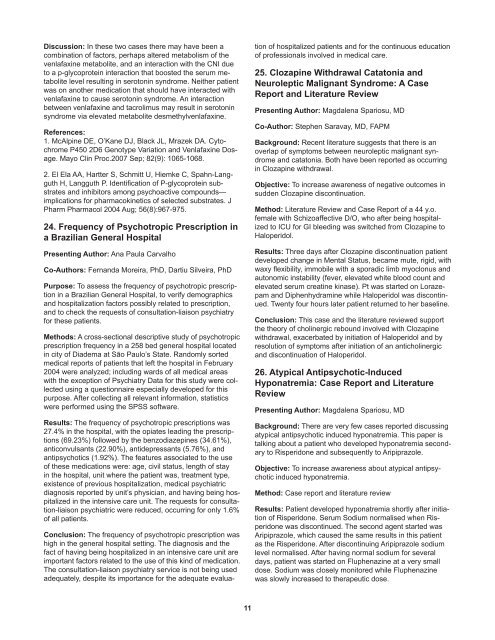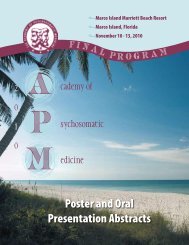Table of Contents - Academy of Psychosomatic Medicine
Table of Contents - Academy of Psychosomatic Medicine
Table of Contents - Academy of Psychosomatic Medicine
You also want an ePaper? Increase the reach of your titles
YUMPU automatically turns print PDFs into web optimized ePapers that Google loves.
Discussion: In these two cases there may have been a<br />
combination <strong>of</strong> factors, perhaps altered metabolism <strong>of</strong> the<br />
venlafaxine metabolite, and an interaction with the CNI due<br />
to a p-glycoprotein interaction that boosted the serum metabolite<br />
level resulting in serotonin syndrome. Neither patient<br />
was on another medication that should have interacted with<br />
venlafaxine to cause serotonin syndrome. An interaction<br />
between venlafaxine and tacrolimus may result in serotonin<br />
syndrome via elevated metabolite desmethylvenlafaxine.<br />
References:<br />
1. McAlpine DE, O’Kane DJ, Black JL, Mrazek DA. Cytochrome<br />
P450 2D6 Genotype Variation and Venlafaxine Dosage.<br />
Mayo Clin Proc.2007 Sep; 82(9): 1065-1068.<br />
2. El Ela AA, Hartter S, Schmitt U, Hiemke C, Spahn-Langguth<br />
H, Langguth P. Identification <strong>of</strong> P-glycoprotein substrates<br />
and inhibitors among psychoactive compounds—<br />
implications for pharmacokinetics <strong>of</strong> selected substrates. J<br />
Pharm Pharmacol 2004 Aug; 56(8):967-975.<br />
24. Frequency <strong>of</strong> Psychotropic Prescription in<br />
a Brazilian General Hospital<br />
Presenting Author: Ana Paula Carvalho<br />
Co-Authors: Fernanda Moreira, PhD, Dartiu Silveira, PhD<br />
Purpose: To assess the frequency <strong>of</strong> psychotropic prescription<br />
in a Brazilian General Hospital, to verify demographics<br />
and hospitalization factors possibly related to prescription,<br />
and to check the requests <strong>of</strong> consultation-liaison psychiatry<br />
for these patients.<br />
Methods: A cross-sectional descriptive study <strong>of</strong> psychotropic<br />
prescription frequency in a 258 bed general hospital located<br />
in city <strong>of</strong> Diadema at São Paulo’s State. Randomly sorted<br />
medical reports <strong>of</strong> patients that left the hospital in February<br />
2004 were analyzed; including wards <strong>of</strong> all medical areas<br />
with the exception <strong>of</strong> Psychiatry Data for this study were collected<br />
using a questionnaire especially developed for this<br />
purpose. After collecting all relevant information, statistics<br />
were performed using the SPSS s<strong>of</strong>tware.<br />
Results: The frequency <strong>of</strong> psychotropic prescriptions was<br />
27.4% in the hospital, with the opiates leading the prescriptions<br />
(69.23%) followed by the benzodiazepines (34.61%),<br />
anticonvulsants (22.90%), antidepressants (5.76%), and<br />
antipsychotics (1.92%). The features associated to the use<br />
<strong>of</strong> these medications were: age, civil status, length <strong>of</strong> stay<br />
in the hospital, unit where the patient was, treatment type,<br />
existence <strong>of</strong> previous hospitalization, medical psychiatric<br />
diagnosis reported by unit’s physician, and having being hospitalized<br />
in the intensive care unit. The requests for consultation-liaison<br />
psychiatric were reduced, occurring for only 1.6%<br />
<strong>of</strong> all patients.<br />
Conclusion: The frequency <strong>of</strong> psychotropic prescription was<br />
high in the general hospital setting. The diagnosis and the<br />
fact <strong>of</strong> having being hospitalized in an intensive care unit are<br />
important factors related to the use <strong>of</strong> this kind <strong>of</strong> medication.<br />
The consultation-liaison psychiatry service is not being used<br />
adequately, despite its importance for the adequate evalua-<br />
11<br />
tion <strong>of</strong> hospitalized patients and for the continuous education<br />
<strong>of</strong> pr<strong>of</strong>essionals involved in medical care.<br />
25. Clozapine Withdrawal Catatonia and<br />
Neuroleptic Malignant Syndrome: A Case<br />
Report and Literature Review<br />
Presenting Author: Magdalena Spariosu, MD<br />
Co-Author: Stephen Saravay, MD, FAPM<br />
Background: Recent literature suggests that there is an<br />
overlap <strong>of</strong> symptoms between neuroleptic malignant syndrome<br />
and catatonia. Both have been reported as occurring<br />
in Clozapine withdrawal.<br />
Objective: To increase awareness <strong>of</strong> negative outcomes in<br />
sudden Clozapine discontinuation.<br />
Method: Literature Review and Case Report <strong>of</strong> a 44 y.o.<br />
female with Schizoaffective D/O, who after being hospitalized<br />
to ICU for GI bleeding was switched from Clozapine to<br />
Haloperidol.<br />
Results: Three days after Clozapine discontinuation patient<br />
developed change in Mental Status, became mute, rigid, with<br />
waxy flexibility, immobile with a sporadic limb myoclonus and<br />
autonomic instability (fever, elevated white blood count and<br />
elevated serum creatine kinase). Pt was started on Lorazepam<br />
and Diphenhydramine while Haloperidol was discontinued.<br />
Twenty four hours later patient returned to her baseline.<br />
Conclusion: This case and the literature reviewed support<br />
the theory <strong>of</strong> cholinergic rebound involved with Clozapine<br />
withdrawal, exacerbated by initiation <strong>of</strong> Haloperidol and by<br />
resolution <strong>of</strong> symptoms after initiation <strong>of</strong> an anticholinergic<br />
and discontinuation <strong>of</strong> Haloperidol.<br />
26. Atypical Antipsychotic-Induced<br />
Hyponatremia: Case Report and Literature<br />
Review<br />
Presenting Author: Magdalena Spariosu, MD<br />
Background: There are very few cases reported discussing<br />
atypical antipsychotic induced hyponatremia. This paper is<br />
talking about a patient who developed hyponatremia secondary<br />
to Risperidone and subsequently to Aripiprazole.<br />
Objective: To increase awareness about atypical antipsychotic<br />
induced hyponatremia.<br />
Method: Case report and literature review<br />
Results: Patient developed hyponatremia shortly after initiation<br />
<strong>of</strong> Risperidone. Serum Sodium normalised when Risperidone<br />
was discontinued. The second agent started was<br />
Aripiprazole, which caused the same results in this patient<br />
as the Risperidone. After discontinuing Aripiprazole sodium<br />
level normalised. After having normal sodium for several<br />
days, patient was started on Fluphenazine at a very small<br />
dose. Sodium was closely monitored while Fluphenazine<br />
was slowly increased to therapeutic dose.



